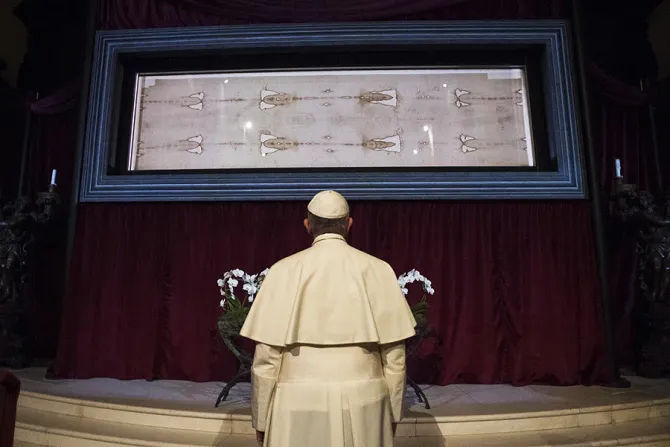Turin, Italy, Jun 24, 2015 / 03:02 am
At this year's exposition of the Shroud of Turin, pilgrims reflected on looking upon what some believe to be Christ's own image – miraculously imprinted on a Jewish burial cloth 2,000 years ago.
"I was transfixed looking at the face," said Peter Taylor, a seminarian for the diocese of Middlesbrough, England in an interview with CNA.
"I just couldn't tear my eyes away from the face of Christ. It was just so mesmerizing that you couldn't look away."
Taylor, who is completing his second year of formation for the priesthood at the Venerable English College (VEC) in Rome, was one of scores of pilgrims to have visited the Shroud of Turin during its April 19-June 24 exposition. Pope Francis also made a pilgrimage to Turin before the event ended.
Housed in Turin's Saint John the Baptist Cathedral, the image on the 14 ft. long, 3-and-a-half ft. wide cloth is stained with the postmortem image of a man – front and back – who has been brutally tortured and crucified.
Taylor said it was especially moving to see the face on the shroud in light and Pope Francis' recent Bull of Induction for the Year of Mercy, set to begin this December: "To see Jesus is to see the face of the Father's mercy."
"To really look upon Christ was really moving," he said.
The staff and student body of the VEC began this past academic year with a trip to the Holy Land, during which they visited the Holy Sepulchre in Jerusalem. Many of these took part in a pilgrimage organized by the seminary to see the shroud during this current exposition.
"To actually have been in the tomb (of Jesus), and then to see the shroud, was a very moving experience I think for everybody," Taylor said.
For pilgrims traveling to Turin to see the shroud, the experience begins a short way from the main Cathedral. Visitors are led quietly through a series of covered walkways which wind through a nearby wooded area. The path is occasionally marked by images and quotes from the local saints, such as St. John Bosco and Blessed Pier Giorgio Frassati.
Visitors are then led into a darkened room where they are presented with a short film, without narration, showing the details of the burial cloth, and what the various markings mean. The film draws particular attention to the wounds on the shroud, emphasizing the correlation between the injuries seen on the image and those suffered by Christ as depicted in the Gospel.
At the conclusion of the film, the visitors are led through the Cathedral itself, which has been darkened to allow the full effect of the backlighting behind the Shroud. They pass by various side chapels, including one containing the tomb of Turin local, Blessed Pier Giorgio Frassati.
Finally, they are led behind the central altar, and allowed to stand, in silence for about five minutes, just a few feet from where the Shroud is on display.
Although tickets are required to be able to see the Shroud close up, it is still visible from the pews which are open to everyone, and it is easy to make out many of the details owing to the overall darkness in the Cathedral in relation to the dim lighting behind the cloth.
Marco Egawhary, a third-year seminarian receiving formation at the VEC for the Archdiocese of Birmingham, also took part in the pilgrimage to Turin. He told CNA he was surprised by the prayerful atmosphere considering the number of people who were going.
"Before the shroud itself is actually very, very prayerful, and that was what really struck me," he said. "It was the quietness of the atmosphere and just the deep sense of prayer that was going on."
The Shroud of Turin is among the most well-known relics believed to be connected with Christ's Passion. Venerated for centuries by Christians as the burial shroud of Jesus, it has been subject to intense scientific study to ascertain its authenticity, and the origins of the image.
Regardless of what the evidence indicates, however, it is not necessary to believe that the Shroud is authentic, according to Catholic teaching. Belief in whether it is genuine or not is left up to the individual.
In light of the question surrounding the Shroud's authenticity, Egawhary explained his attitude in going to Turin: "If this is the shroud that has wrapped our Lord in the tomb, then what would that mean for me and to be praying in front of it?"
Although he believes the evidence suggesting that the cloth is real is compelling, he said his faith does not depend on its being authentic. "Our faith is not based on these sort of exterior signs of things like the shroud or the true relics of the cross. Our faith is based on a personal encounter with Jesus. That's what it is to be a Catholic."
"My experience in front of the shroud being that powerful sort of confirmed it, that interior sense. But if a statement were to be released saying it's not genuine…it wouldn't change my faith."
Echoing the Church's teaching that it is not necessary to accept the Turin relic as Jesus' actual burial shroud, Taylor said the atmosphere of holiness surrounding the Shroud nonetheless left him believing in its authenticity.
"There was a real sense of being somewhere sacred, being somewhere holy," he said.
Even so, "if the Vatican said it wasn't authentic, for me it would still have meant something really moving," he said.
"Having that time in front of the Shroud was a very poignant moment in my life and it always will be."



